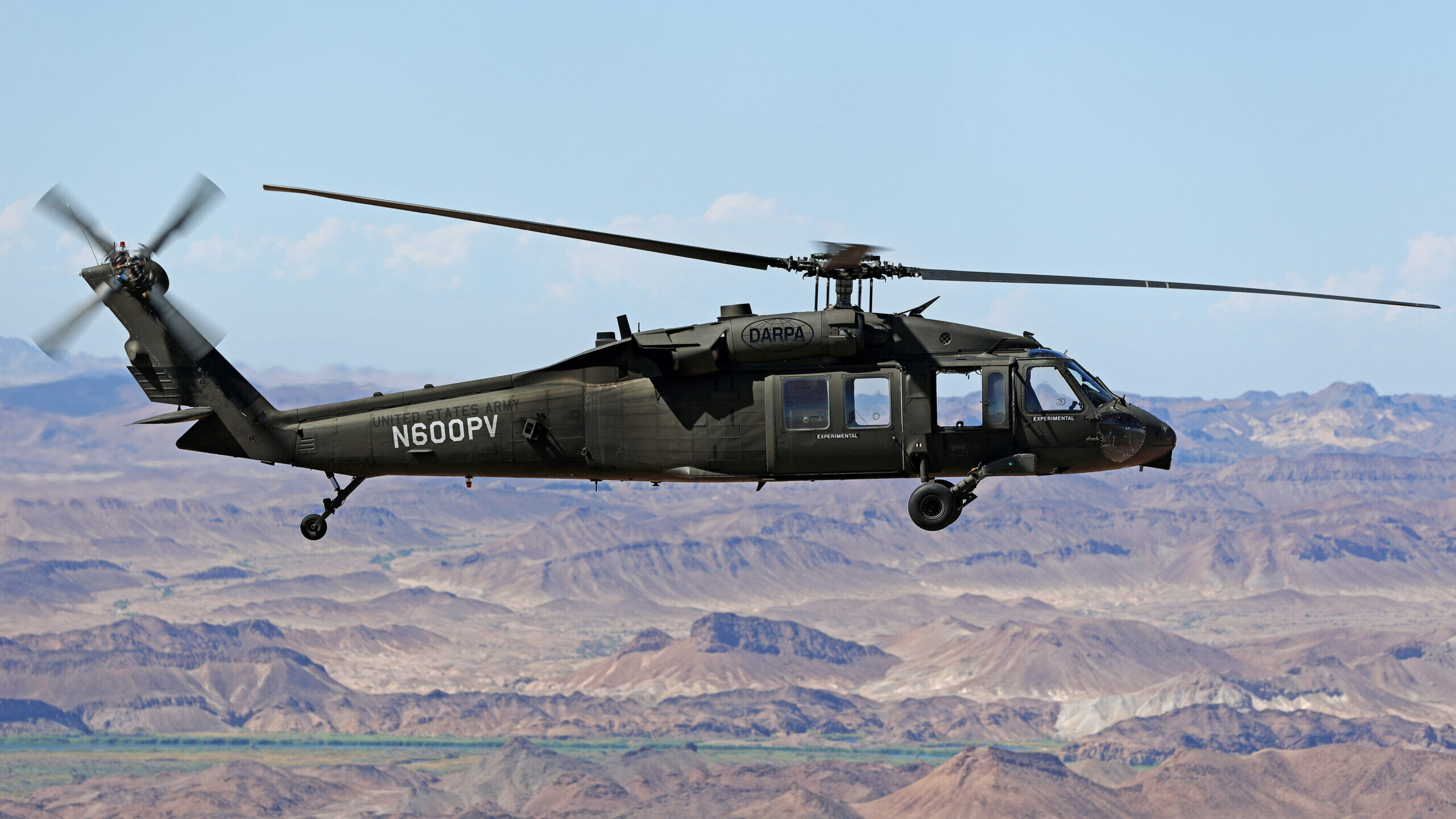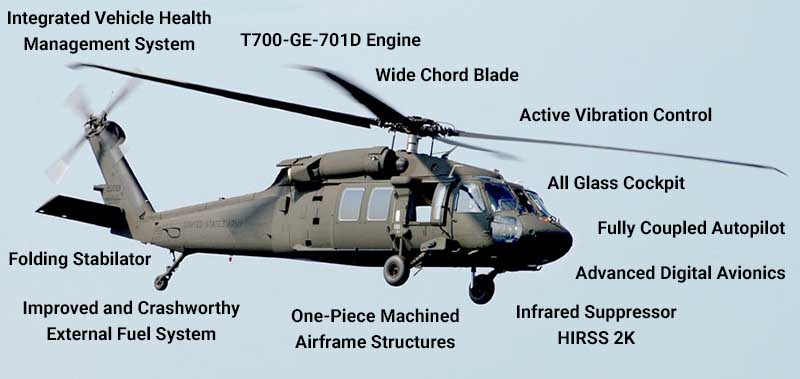The UH 60 and Its Payment to Airborne Procedures in Crucial Objectives
The UH 60 and Its Payment to Airborne Procedures in Crucial Objectives
Blog Article
UH-60: Innovations in Modern Helicopter Style
The UH-60 helicopter stands as a standard in modern-day aviation, showcasing significant advancements in design and technology that accommodate the developing needs of army procedures. Its unification of sophisticated materials not just enhances efficiency yet likewise addresses critical security issues. The combination of advanced avionics has actually transformed functional abilities, allowing for greater situational recognition and decision-making performance. As we explore the development and crucial developments of the UH-60, it comes to be important to consider just how these growths influence not only existing applications however likewise the future landscape of helicopter design.

Evolution of the UH-60
The development of the UH-60 Black Hawk helicopter represents a substantial milestone in aerospace design and armed forces air travel. Introduced in the late 1970s, the UH-60 was created by Sikorsky Aircraft to meet the USA Military's requirement for a flexible energy helicopter with the ability of carrying out a selection of objectives. Its layout emphasized rate, ability to move, and resilience, establishing brand-new criteria for operational efficiency.
The UH-60 includes an unique four-blade rotor system, which enhances lift and security, enabling it to operate properly in diverse atmospheres. Its airframe is created from advanced composite materials, adding to a reduction in weight while preserving architectural honesty. The helicopter's style likewise integrates enhanced aerodynamics, which boosts gas performance and enhances variety.
Throughout the years, the Black Hawk has undergone multiple upgrades to enhance its capacities, consisting of improved engines, advanced flight control systems, and modular systems for very easy upkeep and versatility. The helicopter's capability to carry out missions varying from army transport to medical discharge has strengthened its function as a foundation of united state armed forces procedures. The UH-60 Black Hawk stays a prime example of exactly how advancement in helicopter design can dramatically impact military effectiveness and functional flexibility.
Advanced Avionics Solutions
Advancements in avionics systems have actually changed the capacities of modern helicopters like the UH-60 Black Hawk, improving functional performance and situational awareness (UH 60). The assimilation of sophisticated avionics permits improved navigating, trip, and interaction management, making the UH-60 much more versatile in varied objective profiles
One of the vital features is the innovative electronic cockpit, which utilizes multifunction displays that give real-time information, making sure pilots have instant accessibility to critical flight info. This streamlining of information lessens pilot workload and improves decision-making procedures throughout complicated procedures. Furthermore, the incorporation of GPS and inertial navigation systems makes it possible for exact positioning and course preparation, boosting mission execution in tough atmospheres.
Moreover, progressed avionics systems enhance interaction capacities through safe and secure information web links and voice communication systems, permitting smooth coordination with ground pressures and various other aircraft. The combination of automatic trip control systems better adds to enhanced security and control, particularly in negative weather problems or throughout low-altitude maneuvers.
Engine and Efficiency Enhancements
Engine performance in contemporary helicopters has taken a substantial jump ahead, driven by advancements that improve integrity, power, and effectiveness. The UH-60 Black Hawk, for instance, makes use of the T700-GE-701C engine, which includes a dual-channel, full-authority digital engine control system.
Additionally, the assimilation of engine health tracking systems enables real-time diagnostics and anticipating maintenance, dramatically improving operational integrity. These systems not only alert crews to prospective concerns before they end up being important but also promote much more effective maintenance organizing, thus reducing downtime.

Products and Structural Innovations
Current advancements in products and structural layout have reinvented modern-day helicopter building and construction, improving both performance and sturdiness. The intro of sophisticated composite materials, such as carbon fiber reinforced polymers, has substantially lowered weight while preserving structural honesty. This change not just enhances fuel efficiency yet likewise raises payload ability, allowing helicopters like the UH-60 to perform more diverse goals.
Furthermore, innovations in light weight aluminum alloys and titanium components have added to improved resistance to rust and exhaustion, expanding the life expectancy of essential airframe components. The calculated use these materials has resulted in a decrease in upkeep demands and improved overall functional readiness.

Moreover, the combination of computer-aided design (CAD) and additive production technologies has actually enabled extra complicated geometries and lightweight frameworks, optimizing the wind resistant performance of helicopter styles. These improvements assist in fast prototyping and production, permitting suppliers to respond quickly to progressing goal needs.
Security and Survivability Features
Safety and survivability attributes in modern-day helicopter design have become extremely important, reflecting click to find out more the boosting needs for objective performance in tough atmospheres. The UH-60 Black Hawk, a significant example, integrates innovative innovations to enhance staff and guest defense.
The helicopter likewise utilizes a ballistic defense system, that includes armored staff seats and important systems shielding, lowering susceptability to little arms fire and shrapnel. Improved situational awareness is accomplished via innovative avionics and sensor modern technologies, enabling pilots to detect and prevent threats efficiently.
Moreover, the combination of redundancy in vital systems-- such as dual engines and several trip control channels-- makes certain ongoing procedure also if one system fails. The UH-60 is outfitted with advanced emergency situation flotation protection tools, enhancing survivability in water touchdowns. Collectively, these functions not just enhance the security of workers but additionally boost objective success rates in aggressive atmospheres, demonstrating the dedication to quality in helicopter design.
Verdict
The UH-60 helicopter stands for a significant advancement in modern-day aviation technology, including innovative products, advanced avionics, and durable safety attributes. Its development mirrors a commitment to enhancing efficiency and functional performance while ensuring pilot and staff survivability. The combination of light-weight composites and progressed navigating systems emphasizes the helicopter's adaptability in different army missions. In general, the UH-60 acts as a benchmark for future advancements in helicopter style, personifying durability and versatility in contemporary army procedures.
The UH-60 helicopter stands as a criteria in contemporary aviation, showcasing significant improvements in style and technology that cater to the developing needs of army procedures. As we check out the evolution and essential advancements of the UH-60, it ends up being necessary to consider how these developments influence not just existing applications however likewise the future landscape of helicopter design.
Presented in the late 1970s, the UH-60 was developed by Sikorsky Airplane to fulfill the United States Army's requirement for a functional utility helicopter qualified of executing a range of objectives. The UH-60 Black Hawk stays a prime example of just how development in helicopter layout can significantly impact army effectiveness and operational versatility.
On the whole, the UH-60 offers as a criteria for future developments in helicopter style, symbolizing strength and versatility in contemporary armed forces procedures.
Report this page